Chapter 7. DNA Structure and Replication
7.1 Introduction

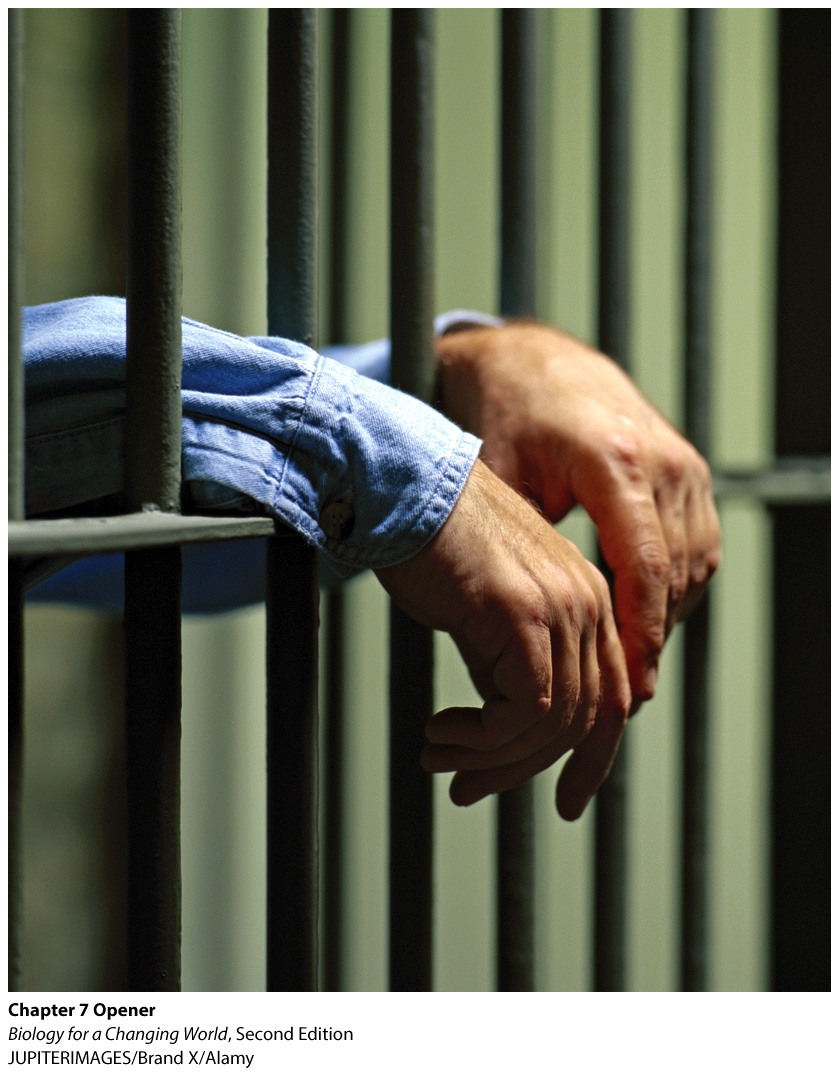
Welcome to the Interactive Study Guide for Chapter 7: DNA Structure and Replication! This Study Guide will help you master your understanding of the chapter's Driving Questions, using interactive Infographics and activities, as well as targeted assessment questions. Click "Next" to get started, or select a Driving Question from the drop-down menu to the right.
Biologically Unique:
How DNA helped free an innocent man
DRIVING QUESTIONS
- What is the structure of DNA and how is DNA organized in cells?
- How is DNA copied in living cells and how can DNA be amplified for forensics?
- How does DNA profiling make use of genetic variation in DNA sequences?
- How does DNA evidence fit into forensic investigations?
7.2 Driving Question 1
Driving Question 1
What is the structure of DNA, and how is DNA organized in cells?
Why should you care?
DNA is the hereditary molecule—passed from parents to offspring—that serves as the instruction manual for building each individual. DNA is found in the nucleus of almost every cell in our body. Forensic scientists can therefore collect DNA evidence from many types of crime scene evidence, such as semen, saliva, skin cells, blood, and hair. This DNA can then be used to positively identify a perpetrator or exonerate accused suspects of a crime.
Roy Brown was convicted by junk science; the only “evidence” linking him to the crime was his teeth, and bite mark analysis is notoriously unreliable. Other types of physical evidence, such as hair samples examined under a microscope, are also problematic, as they are not distinctive enough to positively identify the individual from whom they come. DNA is valuable in forensics because it is unique to each individual. DNA’s structure is the key to its uniqueness in each individual.
What should you know?
To fully answer this Driving Question, you should be able to:
- Understand and describe the origin and function of DNA.
- Describe the location of DNA in eukaryotic cells.
- Understand and describe the structure of chromosomes.
- Understand and describe the number and origin of the chromosomes in human cells.
- Understand and describe the four types of DNA nucleotides and their basic structure.
- Understand and describe how nucleotides are linked to form individual DNA strands.
- Understand and describe how two DNA strands are bonded to form a double helix.
- Understand and describe which feature of DNA varies among individuals, making each of us unique.
Infographic Focus
The infographics most pertinent to the Driving Question are 7.1 and 7.2.
Question Test Your Vocabulary
Choose the correct term for each of the following definitions:
| Term | Definition |
|---|---|
| SUuZ/pyqGso/14KJ/EG8xB70qB8/4QLH/Dzd5WdnM6dlrBYIbwmyir3eLDdr/sIYgYhV15wDTQawNrgQjbjQZyHSOLb05wnjJOcbiN98b4R0xE1S | The spiral structure formed by two strands of DNA nucleotides bound together. |
| ot1sB16sFJVMWRtAVZ4pw+qITHxpwV32zTyKbbKjocEn5Pfq1hcu5ukb5XQzKLjtYyKrcgKrTVpsYV1HQOurqsDdQ6Qyxij4VAnrlJ+I2S/7afBx | The building blocks of DNA. Each nucleotide consists of a sugar, a phosphate, and a base. The sequence of nucleotides (As, Cs, Gs, Ts) along a DNA strand is unique to each person. |
| lVTw7rMpaimS5fPfKwTkMUsIoIFm4RK2PEsXwnfUw9MAxEg0EV4b1iqP2v1TzAKHD8Tas5ravv+md+BpafQ/2K8BCTCJ1pO6oRtXC3u6QWU127vP | The molecule of heredity, common to all life forms, that is passed from parents to offspring. |
| 9EdaE5bXsz+tVKnutW9hXE6Q79FZ94DVGLWqnHF6v4qmIEDu2/8oUCZXFroTckTxAxWOfUJgM6lF7LspzMoHORY3aURMCGDrIdX8LeKVo5XajtPE | A single large DNA molecule wrapped around proteins. Chromosomes are located in the nuclei of most eukaryotic cells. |
| AAZDbJ3CYVmL4zg6zLuZFZmMxQkXeVv/j+eAscdkQDZI8z7lQI5pzZk0RTsnnxqtMmBFRZaltSYgR9rvuHi3YZNoTq71+BuIregY2HUGKxEXHJXJ | Fitting together; two strands of DNA are said to be complementary in that A always pairs with T and G always pairs with C. |
Understand and describe the origin and function of DNA.
Question 7.1
VVoTi8xepJ0ALpIwLyy9r/2xIDvSLoMF9yNf319VxlEnJYJzQuestion 7.2
vdc1Sls72lH508IzFpexmcPT2cFhvDzmVcj9O+6xWacmveykpAS3rnLySJzDjpNtxRNCqWCbjFkAJ6Yz9BgxKK2MMGzpggLMDescribe the location of DNA in the cell.
Question 7.3
d3eA/peBCl+zqpqpeXUrDT+7UP4zeQXrCbjqRpEfYYyQaNUACK6YsGQe2vqhGebcvLQ2vvH41F3hFzesJX8m6h6oSgcJZzJYELFYFSd50LgyfgBadlBbDEFqh9Q+8L1Hb9jlfR53oAIjFEGVldxVA1+5Dg7I21IcgitcPatJ87Wa77bhNXHLrXuBaSDrW3VfsUlL8ZtyN1CLK22MjfkcZbMmGHq7064c+WEknPE4BUm33k1wUnderstand and describe the structure of chromosomes.
Question 7.4

Question 7.5
nUS7YA0Pu6cknx916BFwyx6ShZjP5npLtooC2KkQDmmOKT4lIXLHOxyhPh90kvb0j9u75euhUV1NyEyglo3VROFBje437F8zDRjfxQ==Understand and describe the number and origin of the chromosomes in human cells.
Question 7.6

Question 7.7

Understand and describe the types of nucleotides and their structure.
Question 7.8

Question 7.9
8dyeV3jueYxdfaVynnU/O1+X2DOYFC8yk13yqnj5TTQadRicuVm07O+BDn7U1ce7qEcvqgJIuLRtArIZHM3hBjgkvLhVETq7PacnCbLt0y8L+G0rBpa5s3czl7FyzSuJgXEl7ghxbbpmxRhs8d0v1GhQB5fNR1aN+lIYl/d48nAFuwf8cOiGfRdBVGRqlV4xAocQbb8/mEpEKc9e6GgAOgdR6uBVjGACEXyImy329MXeujN6V3KUnIwl7uLwH5HnoGkQfquKfHDiVPhYg/H03tJfDA25B4TwyqdrEA==Question 7.10
fZAar8xYccOtOBMoYnVmy9hkwA+IvOSEitqIyoZTadw6oIHD/i6kexcNmffGGtczLUadKWMuvo8GiRr0K3ocUwy0BqConlwFmhrwIFCP5o4=Understand and describe how nucleotides are linked to form individual DNA strands.
Question 7.11

Question 7.12

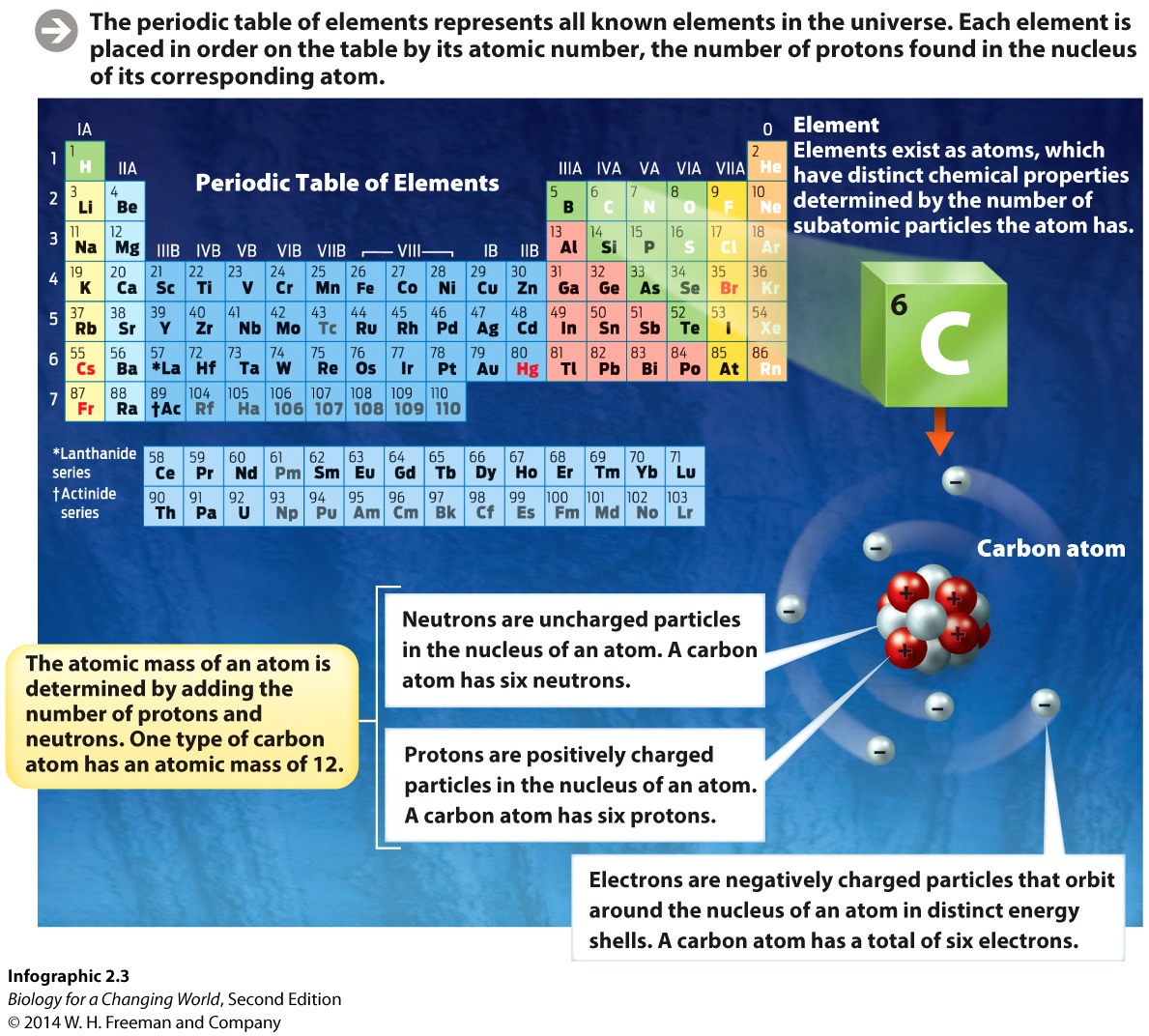
Understand and describe how two DNA strands are bonded to form a double helix.
Question 7.13
a3XCsOHYl6WZvMJX46FxG+i7ARisObupF/rV0OuD7OcZVOosJSH+rrZ55MLzNzX4BqXKydNz1ZNN58Dy36Pb3uthxsGFsI1cRCU/SR3owS5q+4JMQuestion 7.14
f2BR/03N/JPXg7e9lvFUpApqCJc4O2+XhaWahZQRyf59jR++N2miUj+V7TiTzJQPxZrHxV5xSVgV6UiV8Re+Uss6CsX+9buXC3po5Rk4qYspRNI1qktlIs5zgpaRTKkuQuestion 7.15
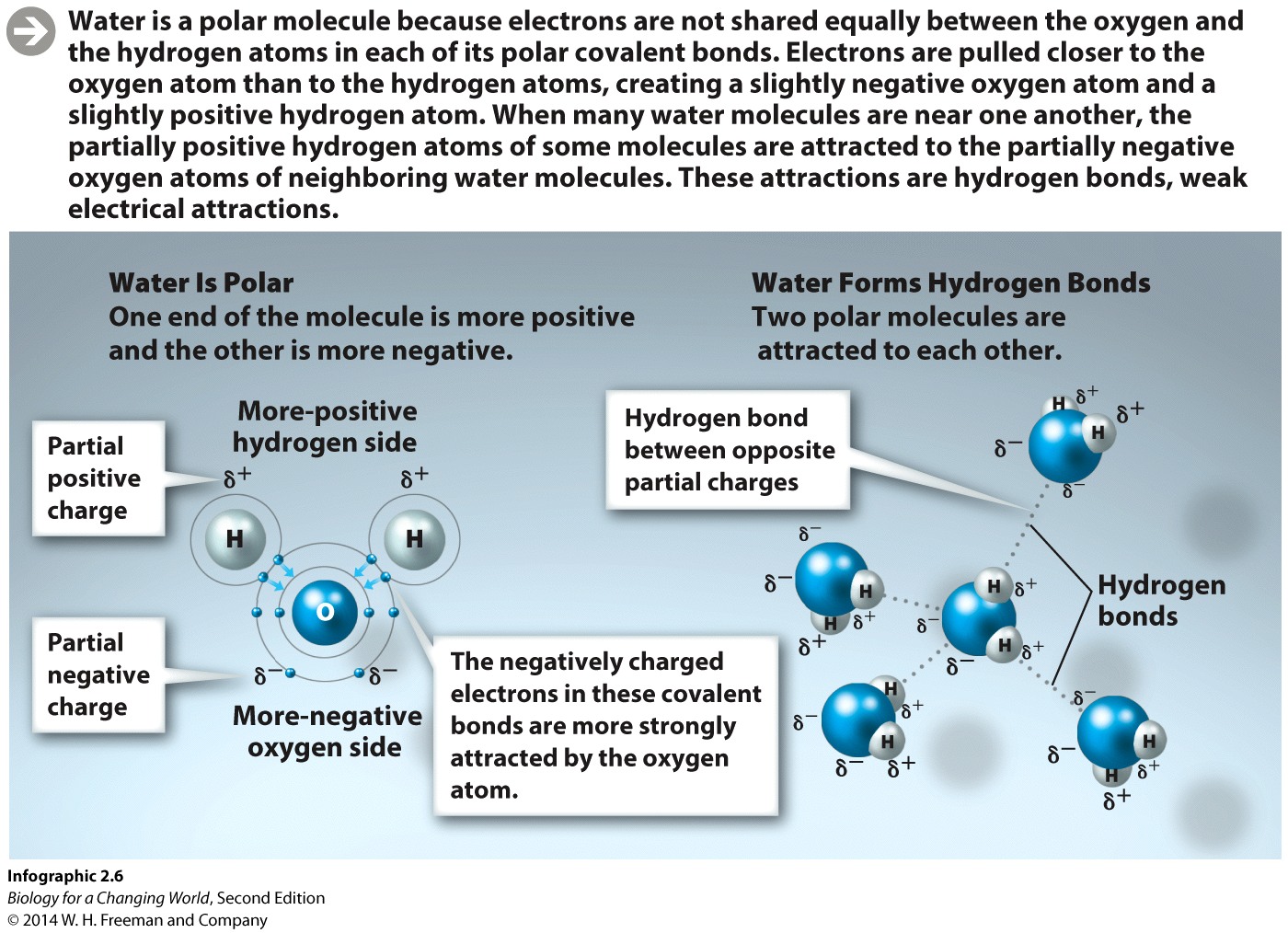
Question 7.16
Here is a list of the abbreviations for the four nucleotides in DNA. According to the rules of complementary pairing, write next to each one the abbreviation of the nucleotide to which it can bond on the opposite strand to create a rung linking two DNA strands:
A5C7cijcTSrFYDmxzHDF/iTM5C+i5JSHYH8Z+bh6gYjC5dFjahyX69w==
Ts6CYR6SO7lkTGHQj6GPd8A==
G+k8133qSNYgQkLvGjG3jeg==
CXfUw05ND1SVzADPjDKguMA==
Understand and describe which feature of DNA varies among individuals, making each of us unique.
Question 7.17
LU9sH84qHKlK0PZYePTOjwM82HGzLiG/sWDJsgFRrGa69/zghaYGkNNc6QtOi6pVdJo5lUYq/bbAq0OTGnyrl2u4NIq7NEd/9/ys87qCj21K6BeFM/dMXM2mXhH/0/SE7aoc2n5ntRYgapg2soeIrhizf7cWl1IfAk3yikKYwAuY/yWFvyt3xFu1Mtc1/OCvLqEZWQ==Review Questions
Question 7.18
RKVIiow+Px0eWY+vD23YghTorGA/z49h38hNdlnYO42hmxAIRwR+QXbihv+gzy0deAIAeF+rVCza//L6qwWqCcYhnYDI3QDYI+XYWoznyghyCROWt82CSdPZoYbhGZIDseHWk/iLzes5g8WDERLZSlwLP6iKfF/bZI1p6KKa1ge+cP8+ylUzpf5DDIA6iDws66NfklO50k3QNA4NeprSXq9OUZR8Wz06xv49qH5Bxc/eOZ8BB2KSrS7QNFM9dyHNWN+EpQqxyvPgaVnGWimxcdUgVSFIMuNGF/uHAVNBm6nBLwGN6ZAk9PjtfNW0wABfk84GGowzQrOVavhiQBijc7tQXQ4QJ8Dt0eAfaK+vpq2JcNZHiBcjTICjYwUOAS0/p8h13L5HdTp26z7urQIrN9byydcF7GPkpaHf/P6Gy9vtrbNyf32t9Fxw+9qKyYv7LXDgEF1fovjYspP4EyrA91pkKsm8fiXmuSqPzOdqFwKuEmAdfryA5wums1AtgWlGPqMARt1u1SNq6bOrL3Cxqav3r1UWYTXftdFp7uFGIY/d11ShIyDtiniFwSHkAjlGm5ovfr78HolQZEtNkdNmZsh0qAw5iVQne2LFTdy5YR1GOBHv2ZW7S4i4T1o7XhsIf0F+/3fOnlCLArDRHV1lJALuzBNKD7HAh5tJniomlaKO3nWau+gvAKtYVCvbfijFeeFFHy6B4OrjDvH5aI5+Aw==Question 7.19
HvJn76kXxq06pYBNrKaSHt2EXX/U7hiovlU32XOosMBfmw+gD0ec2tVVKDgP56I08pmZhNnB6D1icvb5gWz0QU3GTb7t+AYPV0es3pj0NGZ2vKpRusOc6iKeJGe/o+eW92pSkGgp78OWErzicBi2jnahn8RtY8cRxRkIJJz6P8E6MfoBDE4jXOH2wfo2yBJoADiBbXM8WVc7J7wLmXl7P9v2R5jDfabR+JAvPLHcqhy+IWTW9egP2/N+VvqSWQ7l6BRnywpbJc9+ZhCouUh5MTM/47CHOyw7NIOBiS3IqrI40ATKbP2eNzJLk+nHdqHoB7FPUphWebdjapDFAuKzT0HhT/Ym+zAB+S5cSjLQfv58coWO3e/v60049dMeHLM2QTcirzYNNRQCEpPXQJn/3Cp6zfUPgSqKTy41xBdZeFgeirI5Y2FNDuW+7+E=Question 7.20
eIA3ljue7KruIkgOugeUr4GQvH3/9Hp+kvyCJaJQfxfrDojZjhw2AvXess/wRBxqd1VfDKsUYO+3XuRD4fYDL57aVkmU0EMeF9JDXUYIniRL/QVMER0LM2NsIFCB6cRUJEg18OB+clU74Vw6S94kjplSwDqBZdWRJgwZuvPmQeJzIGpvyhljNeLFXF9xUBbteRL77peONBGUvOpdEWYVuPJ88xBcHVCb6UkX3imoNOmRetJTaECy+56t19fB4U7Neh9T5qGaUXvhWmzgWi8mH5RuG1TmqMeSlTPDeSr1GLVchVSrnK6ukXwB3qu6LOLWJVibCGg5VKpsDVBhZTKcX9IvCk/CLXCBNMzF2LVtTp2kM7EKoK1UY0TWUkzQmVMBd/zltjXzpWcNglki++nKh1Ilml11z7qFhuEqoOEAQr6UrVoWAbUkyoPLc3F2mW4UZXyCaarYcNg6lqxQKBJ5suPUtmsYKyLFIro5lhtowA2XiXktVUmTT3qAMsgpxjlot/5RQNAU0LKUUzgwemX/o2nXG8fysODMjpuIguDp61PH6sJj926ZtKKva36L1qRYfUC7IKpDvWDbUPlkcGr+96iCxYjp+X2cW8l/kjFnftXmTMUGB8lQQ1WTb0tPqgI2aC3Uf7zilLlhbssKzkRkG2igHGyLG1eGjQRJdhsxPRLg6sukNUXwXT3EYBUbKA/ZiI4PCWFTPJerAK7tep/K+6oJ+2Z94ZvEh0arffzXScjGWXM0i45krUfNnDfnfqhZlowF64DWe6qVJqsPGCfDUTapDc4Yu7NRUjGQsXSXDz1L/Gfs5tPBTpkFT0kRwIVcDadijP2QYjAbRoSjK6jieIOdJzny+0aBtlmPeu+/IMExl+Q1q/yQ8XoEDL8=Question 7.21
kUgCQ/LAPljw7iRW26eTFBCUyEf/bziU2MS1U0+Qas1SvjjVtwGbYW9imobQMdR2yohTb4ZLnPO8lJVkkwKRbj5RCDVMpJQwj8bU966lFhhFwwuJ5dXQiWVCVz76SX+AyMyNAjOQGzXU8cmc0zWLbDCP4zzyUbQ2AMAx7v2lTbRyCeuiGx+Hrk4uaA8HIFiVQNCmyz7uKL3ZVTYJ9LF4ixXclg2v/XLwM4u/ktJXxRgp1/pZgW4Qxi3PWlfHPZMAMOhFQLBQeRhUun8uqrGqD/Xlk1sD0lL/Qf0aJ/pajhDin3hlqwqmz+50QOJQmeLYZjmLIDO+8t7ZeSrQ2CK9I7hi23g2dwz97YMiPUUASKYWH8Nptcc22NreRYwjh9zo15RIDvCTXvSLDAL/ZfpZ59LSwQQ7JOEX13PtmWeLr82fDT/WIGOSE7WNjtH/AJpB5pKAc3AADAuzpykaOGKazgWYXGyLv8lahkOKsmynIB+2E9NtbHX8rnLuze9tHsCS8Kzu6EOZp8HLXupP69D3RzjuQwDYwo5Jj+CwmZiKpbThdzIDP5HA75p4SZiit9kbVjJUdC9btGnEySCgs0Q22IaeB9HgDZusYeONt4vVRbRB386Ip0YFPMSRRYX3x0YbUqK7fuqIwRtZpfprnu06ZH3dfHS4lI2OxPsV/fJ36vO8aor2YCmDGr5ZRWLtz8/LnduOs2RKi805uytHtBqunA+Jts7rSGWlh1VUkXSk6ifbI+4Ny2PJWWe0wFc+Bvudr23PbCeNSWP4va495WKHEvS7fHejo1BzgeX1p9p/3evb9l8SCDfUozbTxAAh9z8BkOl+wlnY9G3akFydv/uSv7Lg8UeUDS0I9xyN2pHXrA8vL5w5bjUn1Fr5EeRQ/O9UQuestion 7.22
EChvduL8C0zfs23zyIe9F46r2cM+AyRV6tmpluzHphylu12zla6kbZ2rOoyWcc8lOR5wvPfSu50DaZtAhHHE/1caJ3+3TnyzHr+gosJ+RLp/dkPjTSLaq0DLcjAeyrhM8r3758oE2vAHwFmZz+Sj9NQTuR3x5pcDTBfyQWQYHJ/Xnx7tGidS9hn6ihUxiedKyhyKvSTZUFPi8/7U8Wu6R4Vv+ItCY7Abtb6r6U0IhaYVVypwXDhxdyzT7ZyotzPFQuQI3vvHfAf9o6IJ5H1Ucg5Gsb6dE5RcVrkn5yYVrZVIg4eNRYC6COiWX9+LEEhIgRpeCfImSFLiuLZInBO1aivbvoQK1E8seJuDVBLquYAWcR65BsjaW8GUNCklVBefbluvAYplMPD4d4I5dTcwtoz5oMKfhJzE7GsUq8Q9mUVigMYVGaVPtnmZ+d3PDJA5ffk3zUJsFEODbX0aLHoze9dBslmrzmN5W6Lzh2mGesjJ9vp4nR+2TdoaX7O7wlezF8Wc+5TYlFCxjE7Oat8lbPpcn+7PRWaQR8Oss6k3dlVhkMiZzRPIO6VMUt8+56FzXStq71wHe7JRukm67wPYDlefEBDk3tToblLKdM/rRl1sVQ37TeICZFvduT5wAylCAlpNpvJV3r+Q1udrpnS4ivYMHW0G6ssSC7deyoURDljPfwetGVqel0xUyswEL/N1UVACwOfOtFW1nssXS/Jvqg==Related Vocabulary
Question 7.23
Hg4tcbjCp4geqRi+DJ/Oj5FyIftOq6DNkngdJfpdC89zDlmM6VDzRVJY2W7jv2KZci007oUnZRBZunrqDvFVQAXpzfqCuVen1qiYEkBqpq121OpBzgyDSa8demfrsS0c9O4FOc2dHJmeXhNXu/Gi5XkJ+RAR2IpcC4AxNUzoVd0pSO28KyN3sBsVFTkG+ZyX7.3 Driving Question 2
Driving Question 2
How is DNA copied in living cells, and how can DNA be amplified for forensics?
Why should you care?
A major problem with building DNA profiles from crime scene evidence is that crime scene evidence often does not provide enough DNA for analysis. In Roy Brown’s case, for example, the only DNA evidence came from bloodstains and saliva on the victim’s nightshirt. Chemist Kary Mullis developed a method to overcome this challenge. The polymerase chain reaction (PCR) takes advantage of DNA’s natural replication mechanism to amplify (multiply) tiny amounts of crime scene DNA into quantities large enough for analysis. The structure of DNA is the key to its natural replication mechanism.
What should you know?
To fully answer this Driving Question, you should be able to:
- Understand and describe the role of natural DNA replication in living cells.
- Understand and describe the basic steps of DNA replication.
- Understand and describe the role of the enzyme DNA polymerase in DNA replication.
- Understand and describe the composition of the two newly made DNA double helices with respect to the two strands in the original DNA molecule.
- Understand and explain the similarities and differences between PCR and DNA replication.
- Understand and describe the steps of PCR.
- Understand and explain how PCR produces large amounts of DNA very rapidly.
Infographic Focus
The infographics most pertinent to the Driving Question are 7.3 and 7.4.
Question Test Your Vocabulary
Choose the correct term for each of the following definitions:
| Term | Definition |
|---|---|
| tnLs6sO9WdoOIGB42vdkhSOi+ST9Xetq4BN2BGpkocyJxrFOkl5maAr4yigPVIZvXIBCA/TRRtO1pp4GpSz7dFpx1miuxz0sbVQSCAtQVbBTLGtRWEF7JjMHkt0aASSkKkRgMg== | Fitting together; two strands of DNA are said to be complementary in that A always pairs with T and G always pairs with C. |
| sgaIkT28MqngpSjrZmPpBpvToroff8RW6OfYpBnOWhmrT7sFFYKnTgTKxTFZWrzcr1En05oSSKZSesltexuAjZWgfp3iZN5azdgTOfbeeI3eDkd4QuX3Ia+joNg+8vX9CK/87A== | A laboratory technique used to replicate, and thus amplify a specific DNA segment. |
| AWXLV/kpgA8zRsvGTma0IhxTHig3pW3Ey5y4qC+cXDyNV4UffUw+n8Kq6dR/S48QpOlnsLBne6nl4ygLniQuL21lxrDRC52lPyvzY2W1dtQDC4CRSMXxOXH2Gr1gvWwz99XJnw== | The natural process by which cells make an identical copy of a DNA molecule. |
| 851/oP9JHFSkSJXIibFba4dqjHdIEg2fDZOkV//hWx2tUokPr76puTI3tcrJ3klDXhmSzl6qap7r8+zKb64sgISYjo0ecbc1mn4VsN58lyQeFbyNlS/oTq9CMDDKsTRIgP0tgg== | DNA replication is said to be semiconservative because each newly made DNA molecule has one original and one new strand of DNA. |
| CiFCofKrdC69/MPOThJ3cCgmz6ppmg1LQKgAHZMsBxOvnTgiYRhpJp+FMEcM3fhqgk3kTGucPQaKhdlnPPq3N6jqSnGeI//ZsjuyjD6eSc55Fz+YymCqUPAuUDH74kQAd6QpTw== | An enzyme that reads the sequence of a DNA strand and helps to add complementary nucleotides to form a new strand during DNA replication. |
Understand and describe the role of natural DNA replication in cells and organisms.
Question 7.24
W3CaVnl62Te9vi04Pp3TwZKPjI5lP+Lty2+wK8aWNcLKKYEMs9FDRfuwPsa9hStEbfzsHDNIUSPaGeDxyIk4HA==Question 7.25
8p2PGv608W0FSBPd/R8OHXYiSrICnuCFjGXjHmxRCd/r5mVdJwSENxwqljTVeQiEhhTAXC0Qkdvy/ZIe0RQbeCfsDJI=Understand and describe the basic steps of DNA replication.
Question 7.26
QXw0leXaEl7F7qveqSMZXGutkFEQOCazpMluli1VONm75IkXbEkXyWFY6Tn1k/AuAUH2isojMiBov+u1T1ginMIbH+2MtvV/Understand and describe the role of DNA polymerase in DNA replication.
Question 7.27
FZVz7mgLchPFV7G5hce+mI28kZn4KAkJmU4PNSTdz3U1ZZzZeGvNMz7B3cWyzA8F/SIZGdk1oFo=Question 7.28
uxqFSPcKdGp0g+Wo2j7+j9VMiKBuZrWvgI9mhRT+lylirDbMV42xd82eMqPFxR+pkCzYu6Gn9SQ8ed3VmrtpLrhoiDhfC8tfb1X9bDOD5QkS3EiCVaWLL9pryDrTmC/ZOAnymXdM257hlIDgl5Ubom5eJ96GW4xBWKFGpg==Understand and describe the composition of the two new DNA double helices with respect to the two original DNA strands.
Question 7.29

Question 7.30
nWNOCkdtgHTTgsF2UHPLoK8S2IK4slrkOexqWIbUAFPcueYX+ia2H44KOXcVMHIQLATae9EFY3VOwW/qvwl0OeplqwV+LZKwJEBWZzt6XjA6Du5GQy14uEun4XHWSMyUJRS3+Yxw8J8iQ76jN3YD08j1AkGGK6AQMgEzpWSTi5oOiofmg97mt9JRYBeekCan3XdcvXcgAdKNYlC/IjuaI3Jh5R+aWT8cpxmIcoHKXJgMTz+W8Ge48A==Understand and explain the similarities and differences between PCR and DNA replication.
Question 7.31

Question 7.32
1Qq1tW9zMod3sr8fPFVp7dA96aadTl9ZRr77/XiHQn6BYVtdTm8JrTo0XXcyD+r0kVwE++83ajaUiEymkkNhUnJBBtYY74ySUnderstand and describe the steps of PCR.
Question 7.33
CDKpolxB+TJZ/X2KYFaR+bJ/89TxLGJnEa1gGEcos/PCHl3ME0JKJORFkpAix/WayLSm/S5BcfrX/xhFc+zw8SpEITo/08qDZ3WQ8g==Question 7.34
ji0p6ao0gwykw8zswRapvDH0TdnHWJdbp/hB1TOrSBwfpKFISXiYy8cCr7+Kf7ukfJ3IQM4XuJbIRrQABlWlqEIyt8huZqlYLFdWlepIrk6G+dXSqApHc4YjbDm4S6/4hEVpbrrDGMfYR3WO0GP21w==Understand and explain how PCR produces large amounts of DNA very rapidly.
Question 7.35

Review Questions
Question 7.36
hXKLn8ZjJoAegh2/6L4pZmHcDRVgQ17/diMJbs65Avg9lDMSBvUnWf+K+YxPDkltrui/GSDtx19lWWNolyoztxQtcZdT0aF34VVGr+jIYhRIWOp0bzvLznx+0L+uLqOyq4ZpHN58Vl35xcq/md+EN6uD220g6fhBG/vyLBrDNo6weTre89OXh+ktwJJF5CP0RE9ABlObyGhx44qGk7czUcQAKwkDB5BPsdkMOLQa7LYCEOeDvlxMrlMYMbUDG98xTSTsM+hxXq6Y5rXJeQYnB8VxQRjNcA5ZZsUcsEGWDZ8jGSDsxxaOEbPZ/3Vj6UXeN+L7AmJETDk1wd7a+5ZuNhUwOZo1jjYbLXFEtH15peo2IXe0ESuP+ILyxbiQDLb8OIYdBoN98mrt6I8tksrkg3c2Y6JAGinmH7QmGsFPeTSU5zqiDA9ZVuyi5A8ZpVDfTtObl2zF0/Is0cKIAxDOBmJsBurisoWK3DOjd6v9dN2fVMg6sVppHIsPztRVi11tM0/xOMLRce3efufqLCtKhfbYe5eOcP0Xw+Y/rNR0hObJmMCe8WT0b4NH36wHji9KDSdQKcCZy003qaTBdmdj/lpfyzulyyKPBhP/5/7z66w3/3lBnBEFQPoPET1Q770UKDZFuJPZdHHN0gye7v82dRKKPk+vzqxjQmPu9iJ7o8TvGhkTXv21k+EqHcctTT2SyLCF4/aEA7/naUmXaC7FXQlTsbsZ0Sye/8LHIXgzau6AibBdhYW2yiRuyFlI/DqxqKuvAhnOaJ3/Gi8UZu72xJXe7mjDGQzLJ9QuCw2TOoK2+mj5vF2X17wnGOHr+c4pVC+B/keQXYWlVw2CogzFKVbhqk2YqXvg8DyDrLk+fG3Ri2o8v1U3ZNsurpkPUDUQClViogWG4jiCt0aLxpDhVmmWCAfpaB+eTyzrNuXDDh0iUjro7uvCfNDTNS8bQ7iUTMTNy2Ra/tMxwbdRdq8h3+0CYtahyeMX8PihjgAIDVVwxbNKopdfiwdYyhTMmwDBtPGy8nN/lzWNTaMXzTCDNrVwYAJc8WnylyiHnea9ce4el2xLcmX9jPpAFMkxbR0xSKRwQEXuMwgRTE4I0GgMXw==Question 7.37
duK98oQuXsPGsfgkjRtZb0gLdBThIUDk/q70FdwC531k/egIIC5i4C2ARzVeQ6scDsH0n0eiwzS0J2OZWVzzl48kRgo/3Cjd25D98MKDOsOitfdJj9udqIJB305Z+2W3ew6f2NYyNGWrQrZH9bJ1AF8lsZok+xYOvvvBevbJPO9Jc+u6rS9js88zNhvYZ9U036tqRgmbwavFP0AzJ2sqLN6cYj9wKNN9d7afhY0jZDTH892w8mle8V1IRqzxhEfmxL6wgHj+bzEqAZQ5mt6dOHCKV0NKu005jgK7hCzc8Vl0Y+lrwGL+XkcaoRMGqCThna/vB1ln6GvLMgQbBotRiHdpSBjgGQy9lOM/PUW3OOXPxQOm/EyUNLpf8deAP9HAzJ+d1fAEs3CIsPV69my4IkYMUSESBKN0fHXbZrAf19hquzjV9Es8fR/y5E2bMFnxvakHdNVIz8tm5xmaZduMjeo6HfaOaC6GkswQ7XAxbShvdHg9Z0chth24mSTBsmqAqPgBo0gqgcIHElNAMYCrYDCKldcE2q8erYZXPlcnJNjOjrlDe9zQVD1IkEue6mlxdP/onqcr3argKYoNbA2p8/SqxFVZ2KBkAaeJtbMck13SXSziGS49VBZcvfFufPFAQFsGXSMGU+xG1kVMAL8mjg==Related Vocabulary
Question 7.38
8r+4sMEuGBEWvkart8eyRXBBQ8Vn+SK4NGP7SmPqcz+gy7A2fFBRQu5RydP0D7Yb/Lg9rqpiON8p7Zqf8WGQsTmA8kOvI2GgrBJOX0E5f3VLLb4XHlLabvukvMhFupXYa511JCluvm6fa3ccy95fvojHpPjSu1ubwc1Y280D+bkA3g73x1TBPq+ulm0=7.4 Driving Question 3
Driving Question 3
How does DNA profiling make use of genetic variation in DNA sequences?
Why should you care?
With a total of about 3 billion nucleotide pairs in the DNA of each human cell, building DNA profiles of a victim of a crime and all suspects using the entire genome would be extremely expensive and time consuming. Instead, forensic scientists analyze short segments of DNA called short tandem repeats (STRs). These short sequences are present at specific locations on everyone’s chromosomes, but they may be repeated different numbers of times on the different chromosomes of each individual.
To compare DNA samples from a victim of a crime to that of a suspect, forensic scientists create a visual image called a DNA profile. Multiple STR regions from each sample are amplified by PCR, generating DNA fragments of varying length. Gel electrophoresis separates these amplified STRs by length. When the DNA fragments in the gel are stained, each sample reveals a unique banding pattern that can easily be compared with others. This process was used to make profiles of the DNA found on the victim and of Roy Brown’s DNA.
Typically, 5% to 20% of people share the same DNA profile at any one STR site. To match DNA profiles with a high degree of certainty, forensic scientists must analyze many STRs at once. STR repeats at 15 sites are used in forensic DNA profiling, giving these tests a very high level of discrimination. When Roy Brown’s DNA profile proved to be different from that of the DNA taken from the victim, Innocence Project lawyers were able to exclude him as Kulakowski’s murderer.
What should you know?
To fully answer this Driving Question, you should be able to:
- Understand and explain what a single tandem repeat STR is.
- Understand and explain how people can differ in the number of times an STR is repeated along each of their chromosomes.
- Understand and explain how PCR and gel electrophoresis are used together to create a DNA profile.
- Given a picture of a gel, be able to describe the DNA profile of each individual and the similarities and differences among individuals.
- Understand why multiple STR sites must be used if DNA profiling is to be reliably used to match a DNA sample with an individual suspect.
Infographic Focus
The infographics most pertinent to the Driving Question are 7.5, 7.6, and 7.7.
Question Test Your Vocabulary
Choose the correct term for each of the following definitions:
| Term | Definition |
|---|---|
| PIT3oBYWgq2q1fAEfwkGfx8ezGT656tdKsoIajt15gCkgSEiKvyWyjiBNMai7L+3sIX5LQNQVfCMMFcqM3vYl8naaZtEBucR | A laboratory technique that separates fragments of DNA by size. |
| 9kwubnarPc2EF0TM+UIuSVTKwv7lGIAn11HzLl1BytBaEkUFuUHfwJApUu7EvQgMD7uVM9rU2/Rrbih49K+5ZyRhyClljg1n | One complete set of genetic instructions encoded in the DNA of an organism. |
| poJTdkYMAIeWoowsVgyp1FbzNOnS0NZKVt4eMV8EO9K8ObTVV40g69/9cJNbpVxHKfjFcUjeFi3hWRRekwIGrtzmR7/qD3lY | A visual representation of a person’s unique DNA sequence. |
| RrzqNsnv168rtgHJhcWSxVs1yGAED5tv0dWQHxCB+RQNSEDbqLkvXyS7fxL2vo9QFd7o1/ykHqx2sdSXU3p8S+XDcykWkgHv | Sections of a chromosome in which DNA sequences are repeated. |
Understand and explain what a single tandem repeat (STR) is.
In Infographic 7.5, examine the noncoding regions in the depicted DNA molecule corresponding to maternal chromosome 7 (i.e., the regions with the blue backbone) of person 1. Assume that the nucleotides are color coded as follows: yellow, A; red, G; green, C; blue, T.

Question 7.39
qML7Hl0/05YUnsc3kucR9iCeLxOjiUa2qmbSBk7KBXjscPIMDU2AlrfmjGFMeqdrwzF2ibhosOE=Question 7.40
waqp8ldMPO9h2tGCoK/aWJfCIMzEDbFdVatdf8EbxLiEXxV6K1V/iZ9P7dNW0/sltCvywTHgmQqg0bdzDYofUpITQxnM5EuFWiJAEhHbTnknzFehgIttBQ==Understand and explain how people can differ in the number of times an STR is repeated along each of their chromosomes.
Question 7.41

Use the steps from the previous question to compare and contrast the STRs on the maternal and paternal chromosomes shown for each of the three people in Infographic 7.5. Enter your answers in the table.
| STR Sequence | STR repeats on maternal (top) chromosome | STR repeats on paternal (bottom) chromosome | |
| Person 1 | T24kks7PQGokL/DPS7nEJ3XXjvk= | yBhAQ+3VvjM= | h4XZagboIgc= |
| Person 2 | T24kks7PQGokL/DPS7nEJ3XXjvk= | yBhAQ+3VvjM= | yBhAQ+3VvjM= |
| Person 3 | T24kks7PQGokL/DPS7nEJ3XXjvk= | XvVM00l89Is= | L6bSXEGJIC8= |
Question 7.42
b9Yo4fgmGo2W/mmOm4KjY/rRwzLVOVpUKwV2rKSlvx0mh8uBQ5WQtwKSBTukbF9vVYEpnadz1i4gTZl+4xNc08B+jzX0va5M/DlCVmJjL8RwkxEbE8/yckMF2qmBmRPlpFvWexZ6diTn4tiXH5sVBxeoe4V7QjhNjcsfiPY06T+K7C0jdIsZDo7CCJW8+0XQycYCBWK7/elbYDYLwY5uBJNAobFCnMJbTUNdAh6YFKkOZwvw9+y5CrSEcp3K+XBAOoZm3rc6NqE8XnjuUnderstand and explain how PCR and gel electrophoresis are used together to build a DNA profile.
Question 7.43
ZoSeckDZ9o0jdzYg5O82/jPfkN1W94klWWZDUoO4qbjpq5icazLZN6tJhFfLbL082m29ieBgKmbxEzZ7UNnzcTG3vZGbeXsu2XHuYbwd0UAQtl9S/DkEU4adeY1dV7QgQuestion 7.44
0WUwDOwdXRRwTisy7WzMlCL+chh5XGAaNf3q7C5QFQtExdrhDo5IWKp/i8K7XCiGB3m6WGwIYwji/eGxzh50HKJbhqcyqnTruedoxp6/SlASbz4p/fX3RFH+MtoQDd8h0PT1/D8Ab2mMPkHwj+pypk4yiZlE1a0OBOrLQg==Question 7.45
zfImMp35gWTfuT/HWQN6la3pxxOFR8ZX8xKFe5M9p11smZLaYJtxvzcHixzwUnaF9OCStFfqUm+TPM5lUqISUxEpIURO+FC8tv+52IhbGekyZs+yZt0Pg0M0KVPSZFyIVFZfy4D6f6a6zLchI1PYAbe0iSo=Given a picture of a gel, be able to describe the DNA profile of each individual and the similarities and differences among individuals.
Question 7.46
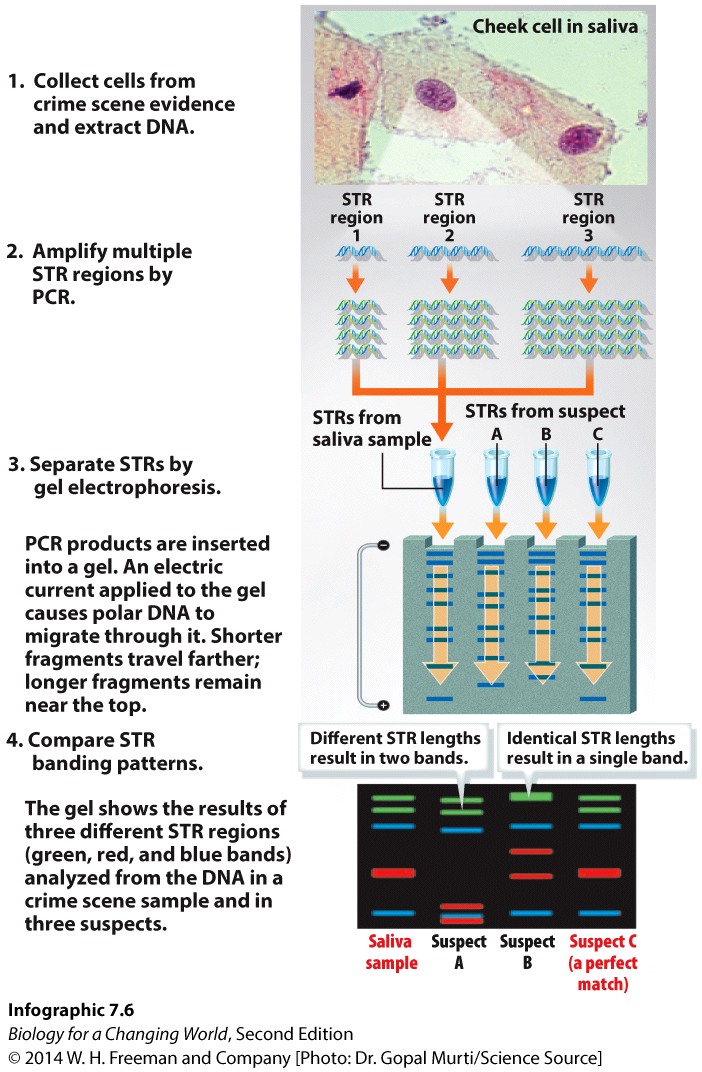
How do we read DNA profiles? Examine the picture of the gel from Infographic 7.6 in your textbook and use it to answer the questions.
Fill in the table with the correct number of different STR lengths for each band.
| Number of STR Lengths | |||
| Sample | Green Band | Blue Band | Red Band |
| Saliva | aPHx0IhLgWWBJq1cPowxTA== | XvVM00l89Is= | 0VV1JcqyBrI= |
| Person A | aPHx0IhLgWWBJq1cPowxTA== | XvVM00l89Is= | XvVM00l89Is= |
| Person B | UvgfJSR3chb765uq4ADtvg== | XvVM00l89Is= | XvVM00l89Is= |
| Person C | aPHx0IhLgWWBJq1cPowxTA== | XvVM00l89Is= | 0VV1JcqyBrI= |
Question 7.47
0iN+mShsdNiGQEqnpQwhC8k/B13qsa2AG1dmxXDi+Cg4pIwbxVit7BTLAE7WDyn9MR5zfHc2a6DLJLDbQDR7NKkj9Z7R5cB1gnwX3hrymVqF9S+gQuestion 7.48
KEApsD1U1xH/en9ydEhPZJqoFxfA+/+Ud+88/G0GPIbrEFUQ9psweLrfO3fGdTNRMvUKBed0jiayGrd4pniqf7D0aFLSULpUW8gvP5/6V40DtQmTQuestion 7.49
8TlZoa+7HCNFHOrHrc3ERc4Hmb9eyIvWht4af3wXb1UjajmuWfWSlxOryDnV0R+RdL3yFqxUBYTHOKzZ6qNzGPdrujgQk4E184vlNxK/Pr3GPjUxQuestion 7.50
1zXczgcfXFQT+IjddXj6rDTt4oBHSgpKH6ixcqm+//ik0AAyreYzvVYsEPgOfgLEshZodg==Understand why multiple STR sites must be used if DNA profiling can reliably be used to match a DNA sample with an individual suspect.
Why must forensic scientists analyze many STRs to reliably match a crime scene DNA sample to an individual suspect? If needed, refer to Infographic 7.7.
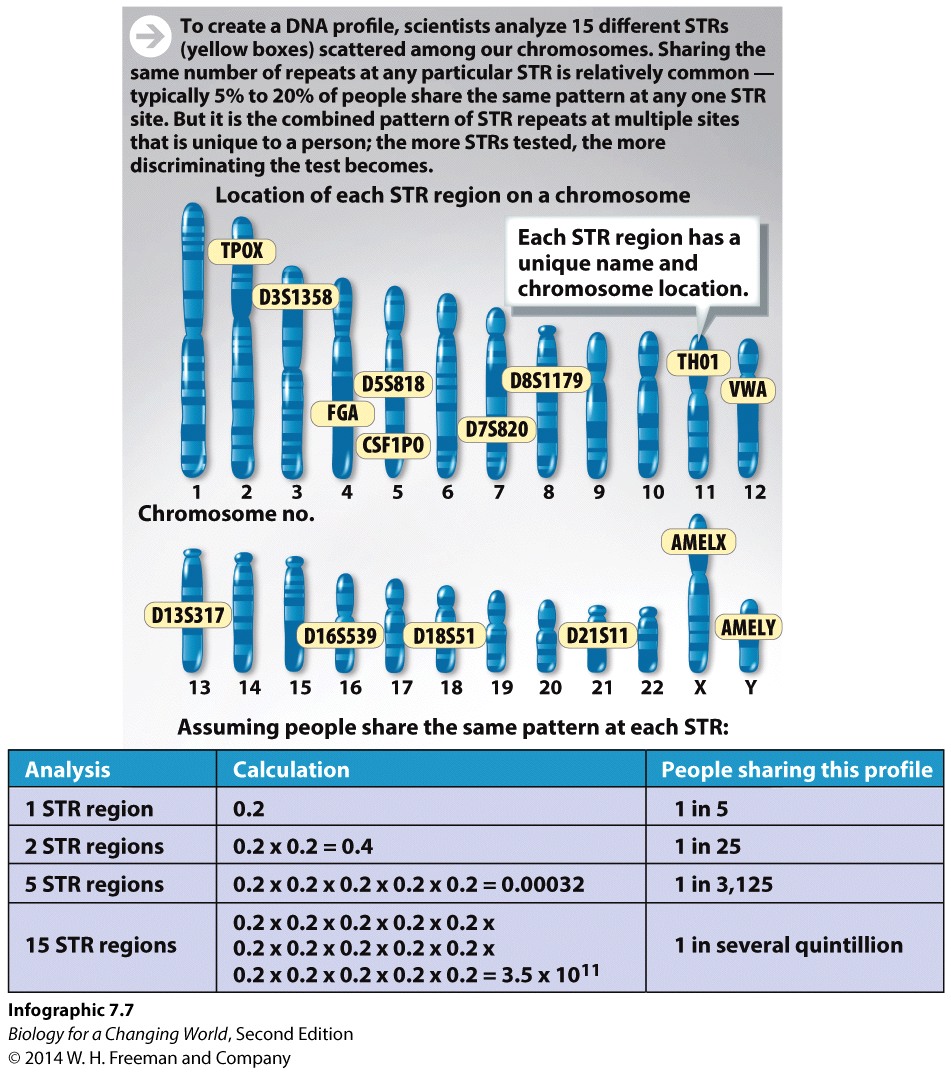
Assume for the purposes of this exercise that the odds of two people sharing STR patterns at any given STR site is 5% (0.05). This is an oversimplification, but it will help you understand the logic of using multiple STR sites. If the probability of two people sharing STR patterns is 5%, then we can calculate the odds of those same two people matching STR patterns at multiple sites as follows:
- Matching at two sites: 0.05 x 0.05 = 0.0025 (0.25%)
- Matching at three sites: 0.05 x 0.05 x 0.05 = 0.000125 (0.0125%)
- Matching at four sites: 0.05 x 0.05 x 0.05 x 0.05 = 0.0000625 (0.00625%).
Question 7.51
yhmbgtHUotN1x86GFWM//b8tDxhHkUcVdl650mcbDvL42C2UGOn/3LLe2TkpY1VTPAdOtvouHXNoQ/SEkucBkBbrwiPHUzjpYsRRFIIUb/kQjywtJwLnHhdL3Iw=At 10 sites it would be 0.0510 or approximately 1 in 10.2 trillion.
At 15 sites it would be 0.0515 or 1 in approximately 327.7 sextillion.
Question 7.52
VoGyTyECUiWaKPLyIRHOCozDCzWkLX88m+V/Fwla4tAccB0/ALCLFfPEIZfL7IvGsEIYGiGcuFca2EcqK6inBvQvn8xciPTM6cq9Y7Sue8oR3NOT7s3mWoJZB6hW6fuqtu1C1lPbi+dW6+kbIVgh2l28c9fFntRwQECksg==Review Questions
Question 7.53
Below are letters representing the nucleotide sequence of one of the DNA strands in a noncoding region within a given maternal and paternal chromosome from two different people. Each contains a hypothetical STR region. Use the diagram to answer the questions.
Person 1
- Maternal Chromosome: ACTGACTTGCCGCCGCCGCCGCCGCCGCCGCCGCCGCCTAG
- Paternal Chromosome: ACTGACTTGCCGCCGCCGCCGCCGCCGCCTAG
Person 2
- Maternal Chromosome: ACTGACTTGCCGCCGCCGCCGCCGCCGCCTAG
- Paternal Chromosome: ACTGACTTGCCGCCGCCGCCGCCGCCGCCTAG
9j9cynvbrnCZybDKUp24jJODNPq0QLgYlN6dKhWpcReUJSVJWxUVnGKPpnZIF6wvR0l2bvyXQtH45E2j8Q3Q7mFIf1xrdLzZlfKfBcS4Y5C3Ym9sC0kCkKE69GlZ0K2WSHN2V5EyuW8=Question 7.54
8y6ZDti8Ax7Ta0HEsIGSSNU5wXLRh1Gl7ToM0ko/KbTdmdbuYwS5Gd7s6MYfUYVKO65v7PI2NVgjrVplWJ+9AEZIumLIi75EQ+ofS5HkAORB6e30X+5RjGeO7pJy0zNyOHF/Jd+UGWLJd+tgxZ6IO8bMevgSoIhC7JVyPkcftLwN1NKHRldDZ363WxstCtF0NMzpNMw3frIKjeIyAUL8DaaFSKjH91gkrHwetUZNUzNWa5jld8DxD4Jr7dYSGB2KQVadqpIumaoE53yyNxelkON4E5rbmqepEx+KAPJAR9Hn27TmvzWD5HZwHRdjIfVTBfmBPB7ex+PdAWwshaqjWqLogI17WYmwZeJlYGM88yKKL8JVzMMWonLIcIzDlOro4/5swJvu5WUg4/pl+5yk860B3mYVAWvKQuestion 7.55
DKJ+vqi2BbXHiNT97hcFFJKTetcd9G7jophaU6C5ZyRFFXHPHE5OwIE5sdBA2kI83NCnj5SCN2oHOXOrcmDwAvEoWh/D26EHfpj05BVxIfs+S4vwio0wFipLJl/nn/T/d5ghWx5fMtQyOOWibPUT58LVFQ/OGg29Tdb/yNYoPpW7UBuXnRXIuhNDZd9bGp3nkCM96xNRM2XYOh5Qbkwxr1iqDtB+mxsJLgrXTDTn20yleKT+n8bGDAdNgFLLPfiae6l0eS9Xp/siPx9x6+WQR1zNlSjqEeIuhAno570qn3T8s5gtvAO3Nj3qbFD8BlM8iCjaWTf4tmA/ngTz2kGI0Z+9TLgFcog4GR4gnuRC40AVmAUHP1JKwukjNhpBK6JG9SLRQsf7mpSK1kG31udX6NBJ1LGGW5IshlzEnA==Question 7.56
0smLy9X09q+I5B7NVyhi0oEbkYkO/4Q/gIVGDV8VFI2hFMk0R6810cAVy4DLEf8XLIG+U+idoCo1rZ5+WopRbkAjuNYUbiq4QGppBh28ecksfnZlXTT2g25widPcrtrjzP3Yn2eFrrtCiyp2s0DCPh6UbY4n+PsSfI7vBzP7Zi3mNqQA8qIWs2lnpFUYxrB+KPjrwgrq11aBXF6fEE/B2WRQrhLJmJARxP3X5RNZoGw=Related Vocabulary
Question 7.57
a+oshyBm+yEmM7107cVhV+xJttsx7Qm5az1FpmZGkAkQhxwSj+brJSm9cCkZL+zPZKckUkxzCBH0vn3kwujDMrpm2n7n98aGRlwQG+eo8e0u3ws6IMFeFqiAPnCAMIv9OynPCIhGPDc+FDUQzkLDBz5alzW6/8iFT/5p+oATg2bcQ79NEZ3WoLGSQAJ4iR+3wcq/jLg5CQY/hg6ZG+Uphblj6xVcQrILjW4yeJTmbw2paHTAtgf/IZUWw6ix6TEUK5QluLrSmwH0CXMY7.5 Driving Question 4
Driving Question 4
How does DNA evidence fit into forensic investigations?
Why should you care?
DNA evidence provides forensic investigations with data that are not biased with human judgment, prejudices, or errors. DNA profiling has proved helpful in more than 190,000 cases and has exonerated more than 300 wrongly convicted people. As a tool in forensic investigations, DNA has become the gold standard of evidence.
What should you know?
To fully answer this Driving Question, you should be able to:
- Understand and describe the origin and function of DNA.
- Understand and describe which feature of DNA varies among individuals, making each of us unique.
- Understand and explain how PCR produces large amounts of DNA very rapidly.
- Understand and explain what an STR is.
- Understand and explain how people can differ in the number of times an STR is repeated along each of their chromosomes.
- Understand why multiple STR sites must be used if DNA profiling can reliably be used to match a DNA sample with an individual suspect.
Infographic Focus
The infographics most pertinent to the Driving Question are 7.1, 7.5, 7.6, and 7.7.
Know all vocabulary words from Chapter 7 to answer this Driving Question.
You are a forensics expert called to testify on behalf of a woman who Innocence Project lawyers believe has been falsely imprisoned for murder. Your job is to answer a series of questions that will help the jury understand the DNA evidence collected at the crime scene but only recently analyzed. To that end, the lawyer will ask you a series of questions; your answers must be scientifically accurate but given in language that the jury, some of whom may not know anything about DNA, can understand. Here are the questions: